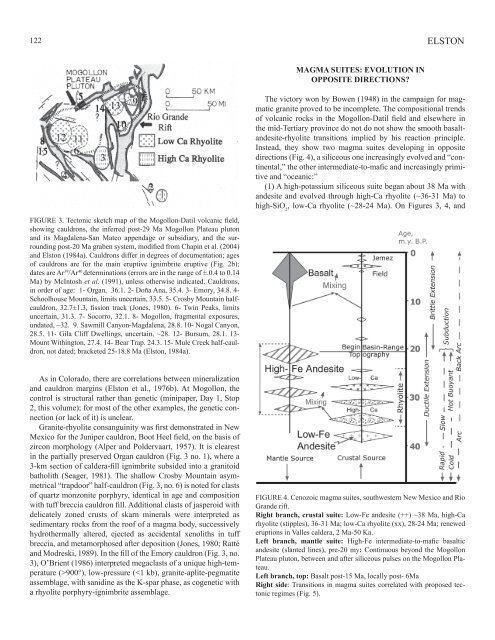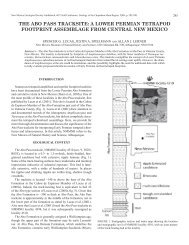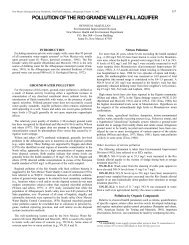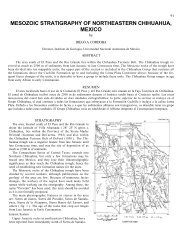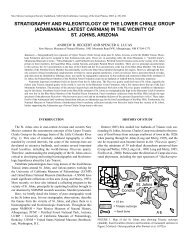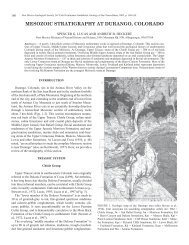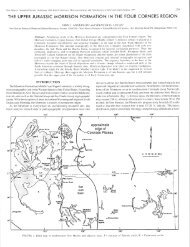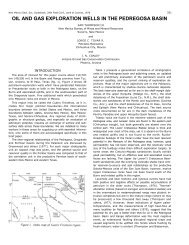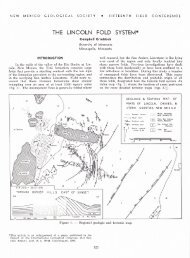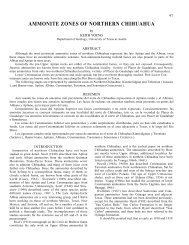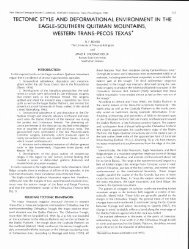When batholiths exploded: The Mogollon-Datil volcanic field
When batholiths exploded: The Mogollon-Datil volcanic field
When batholiths exploded: The Mogollon-Datil volcanic field
Create successful ePaper yourself
Turn your PDF publications into a flip-book with our unique Google optimized e-Paper software.
122 ELSTON<br />
FIGURE 3. Tectonic sketch map of the <strong>Mogollon</strong>-<strong>Datil</strong> <strong>volcanic</strong> <strong>field</strong>,<br />
showing cauldrons, the inferred post-29 Ma <strong>Mogollon</strong> Plateau pluton<br />
and its Magdalena-San Mateo appendage or subsidiary, and the surrounding<br />
post-20 Ma graben system, modified from Chapin et al. (2004)<br />
and Elston (1984a). Cauldrons differ in degrees of documentation; ages<br />
of cauldrons are for the main eruptive ignimbrite eruptive (Fig. 2b);<br />
dates are Ar 39 /Ar 40 determinations (errors are in the range of ±.0.4 to 0.14<br />
Ma) by McIntosh et al. (1991), unless otherwise indicated. Cauldrons,<br />
in order of age: 1- Organ, 36.1. 2- Doña Ana, 35.4. 3- Emory, 34.8. 4-<br />
Schoolhouse Mountain, limits uncertain, 33.5. 5- Crosby Mountain halfcauldron,<br />
32.7±1.3, fission track (Jones, 1980). 6- Twin Peaks, limits<br />
uncertain, 31.3. 7- Socorro, 32.1. 8- <strong>Mogollon</strong>, fragmental exposures,<br />
undated, ~32. 9. Sawmill Canyon-Magdalena, 28.8. 10- Nogal Canyon,<br />
28.5. 11- Gila Cliff Dwellings, uncertain, ~28. 12- Bursum, 28.1. 13-<br />
Mount Withington, 27.4. 14- Bear Trap. 24.3. 15- Mule Creek half-cauldron,<br />
not dated; bracketed 25-18.8 Ma (Elston, 1984a).<br />
As in Colorado, there are correlations between mineralization<br />
and cauldron margins (Elston et al., 1976b). At <strong>Mogollon</strong>, the<br />
control is structural rather than genetic (minipaper, Day 1, Stop<br />
2, this volume); for most of the other examples, the genetic connection<br />
(or lack of it) is unclear.<br />
Granite-rhyolite consanguinity was first demonstrated in New<br />
Mexico for the Juniper cauldron, Boot Heel <strong>field</strong>, on the basis of<br />
zircon morphology (Alper and Poldervaart, 1957). It is clearest<br />
in the partially preserved Organ cauldron (Fig. 3 no. 1), where a<br />
3-km section of caldera-fill ignimbrite subsided into a granitoid<br />
batholith (Seager, 1981). <strong>The</strong> shallow Crosby Mountain asymmetrical<br />
“trapdoor” half-cauldron (Fig. 3, no. 6) is noted for clasts<br />
of quartz monzonite porphyry, identical in age and composition<br />
with tuff breccia cauldron fill. Additional clasts of jasperoid with<br />
delicately zoned crusts of skarn minerals were interpreted as<br />
sedimentary rocks from the roof of a magma body, successively<br />
hydrothermally altered, ejected as accidental xenoliths in tuff<br />
breccia, and metamorphosed after deposition (Jones, 1980; Ratté<br />
and Modreski, 1989). In the fill of the Emory cauldron (Fig. 3, no.<br />
3), O’Brient (1986) interpreted megaclasts of a unique high-temperature<br />
(>900°), low-pressure (


